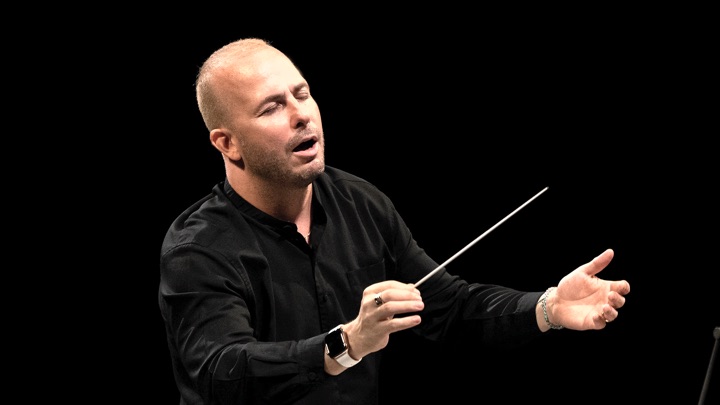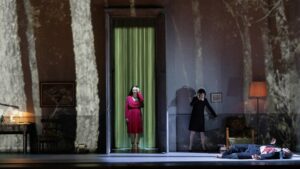On June 8, Verizon Hall, the group’s home since 2001, was rechristened in honor of Marian Anderson, the legendary Philadelphian who broke the color barrier at the Metropolitan Opera. In between that event, Yannick Nézet-Séguin conducted semi-staged concert performances of the enduringly popular La Bohème with a boldface cast of soloists.
The world may know Nézet-Séguin primarily through his work in opera, but in the City of Brotherly Love, you’re more likely to find him helming a Bruckner symphony than a verismo masterwork. Perhaps the combination of such novelty and the name recognition of Puccini’s classic led to sold-out performances: rarely on a summer weekend with perfect weather have I seen this hall packed to the rafters. The forces often delivered the thrilling immediacy that opera can provide, although the results were not always pitch perfect.
Although the genre might not be the Philadelphia Orchestra’s mother tongue, the musicians proved themselves adept at code-switching from the first downbeat. Despite the lack of sets and costumes, their rich, enveloping sound transported the listener immediately to the chilly garret of the first act, gaining in warmth as Rodolfo torches his play in lieu of firewood. The brass communicated the jollity of Christmas Eve in Act II, and Nézet-Séguin reduced the sound to a whisper for the frigid Act III morning.
Throughout, Nézet-Séguin was expansive with rubato, though never dragging, and the detailed reading highlighted wonderful instrumental interplay throughout: the lovely dialogue between flute and viola in “Mi chiamano Mimì”; the doleful violin solo in “Donde lieta uscì” (played by associate concertmaster Juliette Kang, who occupied the first chair for these performances); and the gentle primacy of the harp throughout the score, wonderfully done here by Elizabeth Hainen.
When the Orchestra presented Tosca in 2018, they made the mistake of attempting a fully staged interpretation. This resulted in a bunch of silly concessions that dampened the drama and distracted from the keen musical virtues (I’ll never forget a stagehand walking out and shrouding the Scarpia in a white sheet so that he could exit after his death). Nézet-Séguin engaged the Met’s executive stage director Paula Suozzi to craft a stage picture that was dignified, if not always successful.
The principal singers occupied a raised platform erected in front of the choir loft—similar to the configuration that Cleveland Orchestra has used for many of its opera productions. A row of chairs served as the sole props, and the singers entered and exited as the scenes flowed, rather than remaining consistently onstage. Rather than costumes, the principals wore tasteful evening attire that communicated their characters’ personalities in the moment: a fiery red sequined dress for Musetta at the Café Momus; a tasteful white blouse over a floral skirt for Mimì in the final acts.
Some questionable choices remained. When Musetta instructed Marcello to sell her earrings to buy Mimì’s muff in the last act, why didn’t singer Leah Hawkins remove her own baubles—or at least return from the wings without them? Why did Alexey Lavrov’s Schaunard flounce around the stage like a music-box ballerina? And during “O Soave Fanciulla,” why did Nicole Car and Stephen Costello stand and face the audience rather than expound on their budding love to each other? Longer rehearsal time likely could have led to sharper characterizations, but overall, the staging had a simple, refined quality that was most welcome.
Top vocal honors went to Christian Van Horn, whose lyrical rendition of Colline’s coat aria justifiably earned the loudest ovation of the night. I can’t wait to hear what intriguing colors he’ll bring to Bluebard next week at Carnegie Hall.
Car made for a lusciously full-voiced Mimì and acted the role compellingly. Some pianissimo notes emerged at full voice, and her support occasionally faltered in long-breathed phrases. When she raised her arms above her head near the end of “Mi chiamano Mimì,” I briefly thought I was watching Eva Peron address the descamisados from the balcony of the Casa Rosada—but she shined in all the moments that count.

Hawkins brought acres of personality to Musetta, although she seemed more at home when communicating her vivacious energy in Act II than her rich humanity in Act IV. Unfortunately, there was precious little chemistry to be found with Adam Plachetka’s Marcello. Plachetka began the performance in strong voice but sounded hoarse and wobbly by the end of the evening, his initially rich tone turning wan and gray.
Costello, a hometown hero making his Philadelphia Orchestra debut, struggled throughout. Nézet-Séguin’s forceful playing often covered his bantamweight instrument; in “Che gelida manina,” the maestro turned the Orchestra’s volume down to one so that he could be heard. But would you want to hear such pale tone, constant scooping, and high notes that sounded like a death rattle? Costello also looked constantly bored and disengaged throughout the performance, and seemed to have no conception of character for a role that is central to his repertoire. You could walk four blocks up Spruce Street to the Academy of Vocal Arts and find a half-dozen first-year tenors who would do the role more justice.
Nézet-Séguin imported the Met’s retiring chorus master Donald Palumbo to prepare the Philadelphia Symphonic Choir. The result was boisterous in Act II and perfectly still in Act III, with members of the chorus picking up characterful solos here and there. The Philadelphia Boys Choir and Philadelphia Girls Choir (directed by Jeffrey R. Smith and Nathan Wadley, respectively) were ebullient in their assignments.
Next June, the Philadelphians will take on their perhaps most daunting operatic challenge to date: a complete performance of Tristan und Isolde. Judging from this Bohème, they seem on their way to making their new namesake proud.
Photo: Jessica Griffith







Comments